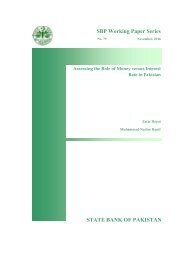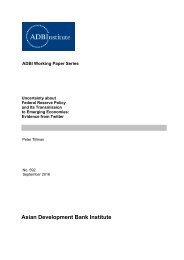SBP Working Paper Series STATE BANK OF PAKISTAN
n?u=RePEc:sbp:wpaper:74&r=mon
n?u=RePEc:sbp:wpaper:74&r=mon
Create successful ePaper yourself
Turn your PDF publications into a flip-book with our unique Google optimized e-Paper software.
In this model, the central bank directly transfers money to households and real money balances evolve as<br />
in equation (17). The real money balances are no longer part of the utility function and household<br />
maximizes the following utility function<br />
U<br />
i<br />
= E<br />
<br />
<br />
t i i<br />
t ln ct<br />
Aht<br />
(31)<br />
t=0<br />
subject to cash-in-advance constraint in equation (29) and budget constraint in equation (20). The first<br />
order conditions for this model are:<br />
w<br />
Et<br />
w<br />
t<br />
1<br />
=<br />
t<br />
R<br />
<br />
t<br />
(32)<br />
t1<br />
A 1 <br />
= Et<br />
i <br />
wt<br />
<br />
t1ct<br />
1<br />
<br />
(33)<br />
1 1 k<br />
<br />
= Et<br />
(1 rt<br />
1<br />
<br />
) <br />
wt<br />
wt<br />
1<br />
<br />
(34)<br />
3.3 Interest Rate Targeting Model<br />
In this model, the central bank operates by following a Taylor type interest rate rule by reacting to the<br />
fluctuations in output and inflation from their steady state values.<br />
This way of modelling central banks’ behaviour has become the workhorse of DSGE models for<br />
analyzing the role of monetary policy in both developed and developing economies. Even though, in our<br />
empirical section, we only found a weak link between interest rates and short run fluctuations in output,<br />
we still wanted to evaluate the role of short term interest rate as a tool of monetary policy in propagating<br />
business cycles in a developing economy. The best way to do this was to use the well established<br />
theoretical framework in literature of modelling monetary policy as a Taylor type interest rate rule in a<br />
simple New Keynesian DSGE model.<br />
For this model, we assume that the economy is cashless and we briefly discuss households’ behavior and<br />
monetary policy in this scenario.<br />
3.3.1 Households<br />
The households maximize utility function represented by equation (31) subject to combined budget<br />
constraint obtained by addition of budget constraint in equation (18) and capital accumulation constraint<br />
in equation (19)<br />
The first order conditions of households are same as those found in equation (21), (22) and (23).<br />
3.3.2 Monetary Policy<br />
In this set up, the central bank conducts monetary policy through Taylor type interest rate rule by<br />
changing policy rate in response to fluctuations of output and inflation. The interest rate reaction function<br />
is given as:<br />
19






